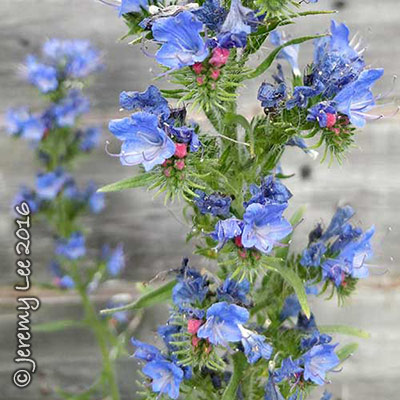
 |
|
Scientific Classifications explained » Amphibians » Ants » Aphids » Bees » Beetles » Birds » Bugs » Butterflies » Caterpillars » Damselflies » Dragonflies » Earwigs » Flies » Frog/Leafhoppers » Fungi » Galls » Grasshoppers » Harvestmen » Hoverflies » Lacewings » Ladybirds » Leaf Mines » Lichens » Mammals » Millipedes » Mosses » Moths » Sawflies » Slugs » Snails » Spiders » Trees & Shrubs » Wasps » Wild Flowers » Woodlice » Postboxes |
UK Nature > Wild Flowers > Blue & Purple Wild Flowers > Echium vulgare

Scientific Name: Echium vulgare Common Name: Viper's Bugloss Echium vulgare, commonly known as Viper's Bugloss, is a hairy plant with dense spikes of bright blue, funnel-shaped flowers. It is found on chalk grassland, sand dunes, cliffs and disturbed ground, and is in bloom from May to September. Usually biennial, but can be annual or even perennial. It provides food for a range of insects, including Buff-tailed and Red-tailed Bumblebees, Large Skipper and Painted Lady butterflies, Honeybees and Red Mason Bees. Viper's Bugloss may have got its common name, 'Viper', from its spotted stem, which is said to resemble a snake's markings, or from the shape of its flowers, which look like the head of a snake. 'Bugloss' comes from the Greek meaning 'ox's tongue' and refers to the rough, tongue-shaped leaves. Scattered distribution in the UK, most common in the south. Somewhat declined since the 1930s, due to agricultural intensification and habitat loss. |
|

https://www.uknature.co.uk is a website dedicated to showing the immense diversity of UK nature and wildlife. Our vast range of habitats, from lowland arable to snow covered mountains, from storm-ravaged coastlines to peaceful inland freshwater lakes and rivers, from dry, sandy heaths to deciduous and coniferous forests, all these habitats contribute to the abundance of UK nature. We have wild birds in huge numbers either residing or visiting our shores (597 recorded species as at July 2013) and we must also not forget the humble back garden with its grass lawns, flower beds filled with nectar rich flowers, shrubs and trees, all designed to attract huge numbers of insects such as bees, moths, butterflies and hoverflies; and finally the small ponds which provide safe havens for frogs, toads, newts and even slow worms and grass snakes. www.uknature.co.uk is the showcase for my personal passion, photographing uknature in all its glory. I sincerely hope you all enjoy the fruits of my labours. This site and all images contained therein is © Jeremy Lee 2004 - 2025. All Rights Reserved. Site design by Jeremy Lee. Site development & IT Support by Stuart Lee. |